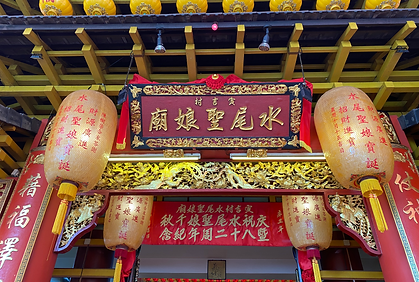
Cultural Attractions
Do you know of any tangible heritage of the Hainanese in Singapore?

Attraction 1:
Kheng Chiu Building
(Hainan Federation)
Documentary

Kheng Chiu Building (Hainan Federation) was established in 2019. Fu Yong Ping, the chairperson of Kheng Chiu Tin Hou Temple, takes on the role of chairperson of Hainan Federation.


Tin Hou Temple
&
Kheng Chiu Building

Kheng Chiu Tin Hou Temple
The Kheng Chiu Tin Hou Temple in Singapore is the 78th temple worshipping Ma-tsu goddess in Asia. It was built by the Hainanese dialect group in Singapore and the main deity is “Tin Hou Sheng Mu” (Ma-tsu). Although Ma-tsu is not the main belief of the Hainanese, Tian Hou Temple is still one of the important temples of the Hainanese in Singapore.
Why is that so? It is said that when the Hainanese came to Singapore by boats, the temple once provided them aid and shelter.



Do you want to know more about the fun facts of Tin Hou Temple? Click here!
Story Adaptation: Singapore News,2018



Attraction 2:
Yan Kit Village
Chinese Temple

(Shui Wei Sheng Niang Miao) was established in 1939.It is currently located at Yan Kit Village. The temple worships the Shui Wei Sheng Niang, also known as “Nan Tian Fu Ren” and the local deity of Hainan. Shui Wei Sheng Niang is not a deification of historical figures but a native deity of nature. She is regarded as the Patronus by the fishermen.
In the 20th century, the Hainanese worshipped the Shui Wei Sheng Niang and Ma-tsu, to pray for safety and to ensure safe navigation. There are three important festivals for the temple namely The birthday of Shui Wei Sheng Niang, Hungry Ghost Festival, and the Opening of Walth Vault.

Attraction 3:
Purvis Street
Feature of Arcades'
Origin of Arcade Building
The arcade architecture is a by-product of modern street house architecture. The ground floor of the architecture would set back along the street, leaving space for pedestrians to walk. Modernised Veranda first originated from Beniapukur in India, and the locals there called the building “Veranda”.
The founder of Singapore, Stamford Raffles, designed the local architecture based on the “street houses ‘corridor”. The corridor was later known as ‘Five-foot way’. The verandas in the Nanyang region are built side-by-side, with its front being a shop and back home; it is built mainly for commercial and residential purposes.
Singapore is one of the few architectural gems in the world where different ethnic groups such as , Chinese, Malaysians, Indians, Arabs and many other ethnic groups come together, giving rise to the Arcade in the context of the fusion of Chinese and western cultures.
The arcade building in Singapore uses a variety of bricks and wooden structures. In terms of form, it is the merger between residential homes and commercial shophouses. It terms of function, the building combined complex business, residence, transportation, and leisure, making it a flexible, humanise, and locally distinctive urban building.
Currently, arcades in places such as Bugis Junction, Joo Chiat, and Chinatown have been preserved. They date back more than a century, and have become national heritage sites.
Singapore's Arcade Building

海南二街 正面

海南二街 侧面

海南二街 正面

Haikou arcaded street is a unique streetscape in Haikou. The design on the upper and middle sections are vibrant and eye-catching.
On higher levels of the building, wooden and long and narrow sized windows, known as Venetian windows could also be seen. These windows are commonly seen in Singapore.
There are various designs of the window edges, such as round arches, pointed arch, triangle and so on. Some window sills have various patterns or relief sculpture. The colour of the window sash includes dark brown, green, blue amid white, etc. The various windows showcase their style, and dizzying the eyes of its audience.





Arcade not only has the traditional Chinese style, but it also incorporates the European classical architectural style throughout its architecture, such as relief sculptures, Roman columns, and round-arched windows.

Adding a corridor in front of the room was a design by the British to create a cool and comfortable living space, and this special architectural design helped keep out the heat.
Hainan's Arcade Building


Want to know more about the Hainan arcade's historical background?
Click here!

Attraction 4:
Former Hainan Village
 |  |  |
|---|---|---|
 |  |
The former Hainan Village was home for the Singapore Hainanese from the 1930s to1980s.
It is currently located at the Thomson Natural Reserve, preserving the leftover architecture such as brick walls, water wells and stairs, and the relics of a rambutan plantation by the historian Han Wai Toon in his backyard from the 1960s.
This historical site is living proof that the Hainanese in Singapore has once lived and planted their roots here. Till this day, the Singapore Hainanese will return to this place where they once lived to reminisce about the old days.
Hainanese Opera
参考资料:
-
无名氏 (无日期)。Yan Kit Village Chinese Temple 水尾圣娘庙。廟宫。上网日期:2022年1月27日。检自:http://www.beokeng.com/disptemple.php?temple=yan-kit-village-chinese-temple
-
百度百科 (无日期)。水尾圣娘。百度。上网日期:2022年1月27日。检自:
-
https://baike.baidu.com/item/%E6%B0%B4%E5%B0%BE%E5%9C%A3%E5%A8%98/9059989
-
百度百科 (无日期)。骑楼 (近代商住建筑)。百度。上网日期:2022年1月27日。检自:https://baike.baidu.com/item/骑楼/79658
-
林诗成 (2009年4月10日)。新加坡的“海南街”。海南省人民政府(来源:海口晚报网)。上网日期:2022年1月27日。检自: https://www.hainan.gov.cn/hainan/lsyg/200904/56c5f0eae170423dbf9626080e759e94.shtml
-
新加坡海南会馆 (2013年)。新加坡琼州会馆/天后宫史略。新加坡海南会馆。上网日期:2022年1月27日。检自:http://hainan.org.sg/index.php?m=index&a=qunzhou
-
新加坡新闻 (2018年11月7日)。促进宗教和谐 弘扬妈祖精神 琼州天后宫主办世界宗教和谐暨首届妈祖文化节。新加坡新闻。上网日期:2022年1月27日。检自:https://toutiaosg.com/349469
.png)